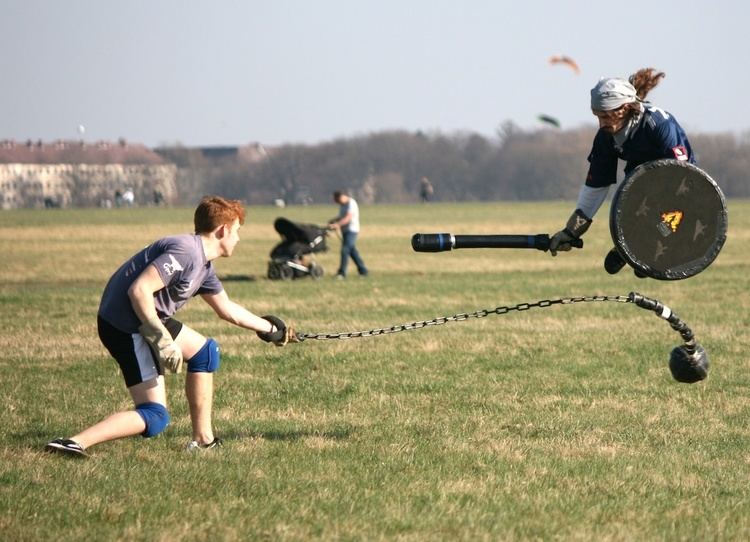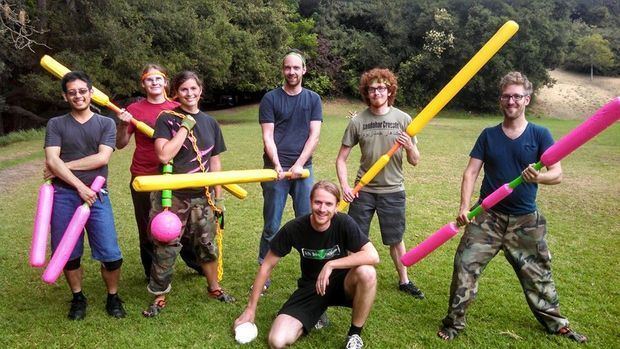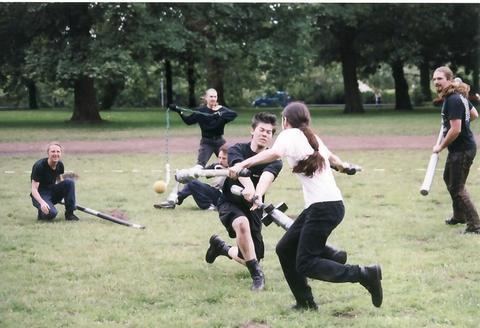First played 2007 Venue Field | Type Ball game, team sport | |
 | ||
Equipment Skull-shaped ball, prop weapons, stakes Country or region | ||
gag vs rigor mortis jugger final 12 deutsche meisterschaft juggerliga
Jugger is a sport inspired by the 1989 film The Salute of the Jugger (released as The Blood of Heroes in the United States), in which a game of the same name is played. The film version was invented by the film's writer-director, David Webb Peoples, especially for the movie. The transformation into a real sport happened independently in Germany and Australia.
Contents
- gag vs rigor mortis jugger final 12 deutsche meisterschaft juggerliga
- Trendsport jugger pompfe trifft auf hundesch del spiegel tv
- Equipment
- Roles
- Roles in the film
- Australia
- Positions
- Timekeeping
- Hits
- Ireland
- United States
- Hits and strike zones
- Community sites
- References

Jugger as sport is gaining popularity in Germany, especially with university and college teams, with its own league. There are teams in Australia, Ireland, England, Poland, Denmark, Spain, Sweden, Colombia, Costa Rica and The Netherlands. A couple of variations of the sport are played in the USA. Some follow the International version (e.g. Germany, Ireland etc.) while others use a model that more closely resembles The Game that is played in the movie.

The first ever Jugger international tournament took place in Hamburg, Germany on 20 May 2007 between the Irish team Setanta and a number of the Northern German teams. In 2008, Australia and Ireland came to Germany to take part in the 1st German Open, making it the first two-continent tournament in Jugger.
Trendsport jugger pompfe trifft auf hundesch del spiegel tv
Equipment

Traditional timekeeping is done with a gong and 100 stones: The stones are thrown against the gong to keep time. 100 stones per third, 3 thirds per game. Alternatively a drum or similar is used, with the drummer keeping count of each beat (known as a stone). 100 stones per third, 3 thirds per game. In conjunction with official equipment, smartphone applications such as Jugger Stones or Jugger Match. are sometimes used for score keeping and/or drum beats.
Roles

A team is composed of the 8 following persons, 5 of which are allowed to be on the field:
Roles (in the film)
In the film The Salute of the Jugger (or 'The Blood of Heroes'), each role is heard at least once in the dialogue:
Australia
The objective of the game is for the team's Qwik to get the foam dog skull, or jugg, onto the opposing teams "stake" (mound) to score goals, while minimising the number of goals the opposing team scores within the time limit. The enforcer's role is to defend their Qwik from the opposing players.
Positions
Australian Rules Jugger is played with two teams of five juggers. Three enforcers with weapons, one chain and one qwik.
Qwiks
The Qwik is unarmed and the only player who can carry the skull. The two Qwiks start outside the centre circle and when the game begins wrestle for the skull. The enforcers may not enter the circle until the skull or the whole body of one of the Qwiks leave the circle. A Qwik's hands and forearms are not considered a hit zone and may be used to block.
Enforcers
The enforcers wield various classes of padded weapons (listed above)
There can be a maximum of two of the same class of weapon among the other enforcers. An enforcer can pin another player by resting their weapon on the hit player within the first stone of their penalty. Paired shorts can pin two opponents. The qwik cannot be pinned.
Chain The position of chain wields a ball-and-chain of plastic and foam up to 320 cm long. The chain can have a 50 cm handle (replacing 50 cm of chain) with a striking surface which can be used to tag opponents for a regular Spar penalty count.
Timekeeping
Games consist of three thirds. The thirds last 100 stones. Traditionally kept by throwing stones against a gong, though other methods such as drums are often used. Stone beats are 2.5 seconds apart.
Hits
Stone penalties for hits vary between countries from three to five for the Spar/Pompfen and five and eight for the chain. Australia plays three and five.
When a player is hit by the other team they take a knee and are inactive for the count of three stones.If hit with the ball of the chain they take a knee for a count of five stones.Head hits incur a penalty on the hitter of five stones for safety.Strike locations are from the neck down (excluding hands on weapons or the entire forearm from the elbow down for qwiks). All strikes in jugger are touch, so there is no need to hit heavily or try to cause injury.
Ireland
As with German and Australian Jugger, the goal is to score more points than your opponents within a time limit. These time limits are counted by a regular beat or "stones" on a drum amounting to about two seconds to every stone. A tournament game is played for two sides of one hundred stones each but during normal training sessions there are no spare players to beat the drum so the game is usually played as the first to 10 points or similar.
The game itself is played with two teams of five, with substitutes waiting behind the starting line. A full team consists of a runner, a chain, two staffmen and a chainblocker. Although weapons other than staffs can be used, staffs are by far the most common in Ireland. There can only ever be one chain per team at one time.
The pitch itself is rectangular with two "mal" (German, goals) at either end in the form of a foam square with a depression to receive the skull. The "Skull", a rubber dogskull serving as the ball, is placed in the middle of the pitch and at the end of a count by the referee or one of the captains both teams run towards the centre of the pitch and try to score.
When both lines reach the centre of the pitch the players try to "tap" each other out. This is done by lightly tapping the opponent with a legal surface of your weapon on a legal body part. In Ireland this means anywhere below the neck and above the wrists. Headshots are avoided and if a pompfe hits the head before a legal target the tap is discounted and the player must withdraw their weapon before hitting again. While a hit on the head after a hit on a legal target is still counted it is frowned upon and avoided. If both players tap each other at the same time, or indiscernibly closely, both players are considered hit and go down. This is unlike in German rules where hits within half a count of each other are allowed, or Australia where both players play on in case of a double.
When a player is tapped out they drop to the ground with one knee touching the ground. If they have been hit by a staff or other pompfe, they stay down for five stones. If they have been hit by a chain, they are down for eight stones. The count begins when the knee hits the ground and while the player may move to retrieve a weapon they must return to where they were hit before they start playing. A kneeling player may also pivot around on their knee provided they don't lift it.
While they are down another player may "pin" them by holding their staff on them. A chain player may not do this. As soon as their count is up any player except a runner must attempt to stand again. As soon as their knee leaves the ground they are considered standing and can be hit although they must be "fully standing," before they can hit others. As a result of these rules it is possible to abuse them by holding a pompf just above a person waiting to rise. They must rise as soon as they can and they are tapped out for another five stones as soon as they do. As a result, a rule was instituted that a pompf must be either pinning a kneeling player or three feet away, an exception is where there are two players kneeling in close proximity and it is impossible to pin one without having your pompf close to another.
The purpose of all this is to break a hole in the opposite line and allow the runner a chance to score. Once a runner scores both teams reset to either end of the pitch, the skull is placed in the centre by the schiri, referee, and the victorious team is awarded the point. The game is quite comparable to Hamburg rules jugger, from which it originates, and is least similar to Australian jugger. Most of the following comes from IADT (Institute of Art, Design and Technology), in Dublin with plans to expand into UCD (University College Dublin) and DCU (Dublin City University), and is also played in the Institute of Technology, Tralee.
United States
A game based on the same movie developed within the game Amtgard and is referred to there as "Jugging". Being based on the movie, there are similarities but there is no other direct relationship. It is basically a game within a foam larp, but very popular.
The Competitive Underground Jugger League or C.U.J.L. (pronounced "cudgel") is a group based originally out of the American Midwest that began in 2009. In their league the "weapons" are made of rattan with impact surfaces padded with strips of mountain bike tire. Helmets, knee guards, and hand protection are required gear as outlined in their Codex. Teams in the league compete each season for the "Bucket of Blood" trophy.
The Carolina Aggressive Jugger Association (C.A.J.A./CAJA) is another American jugger league that aims to hold truer to the movie than its European counterparts. Formed September 2010, they are still refining their rules and regulations. Drawing from C.U.J.L., European leagues, as well as the movie itself; they allow use of much denser cores, hardwoods specifically, (with metal being allowed only on chain weaponry and shields) and require only one layer of closed cell padding at least 1/2 inch thick. This of course insists the implementation of armor covering vital areas; the head, a majority of the ribcage, forearms, shins, and the entire spine, may be eventually required to be protected. Also their field is considerably smaller than most at 75 ft by 40 ft; this is also subject to change. The smaller field was chosen to compensate for the additional fatigue caused by armor usage as well as to place players closer to one another, which CAJA felt was more accurate than the usual playing field. Currently playing skirmishes in Longs, South Carolina (just out of North Myrtle Beach) players ages 14 and up are welcome to come watch or participate as either players or support crew.
The USJL (United States Jugger League) is organized with the intention of building Jugger teams that play by similar rules to those found internationally so that the US will have an opportunity to take part in the international tournaments. The USJL rulebook and other information can be found on the USJL website.
Jugger Ohio is a group formed in October 2010 that is based in the historic town of Marietta, Ohio. Using very similar rules, field size and equipment as its international counterparts, Jugger Ohio has also embraced social media as a viable way of communicating. It continues to organize weekly and bi-weekly matches via Facebook to great effect. They are organizing the first ever American Jugger tournament, dubbed "The Dogskull Classic", planned in the style of the German Open. This event is slated for August 13, 2011 in Marietta Ohio.
The Red Dirt Jugger Club is based in Oklahoma City and was formed in June 2010. Oklahoma plays with German style rules, and has grown to over 50 members. A league is being formed in the fall of 2012 and 7 teams of 6 have been formed and are preparing for league play. Oklahoma City and its outlying suburbs play every weekend.
Hits and strike zones
A variant of Jugger is played within the UK’s Lorien Trust LARP system, the world championship being held at the system's sporting event the Great Edrejan Fayre.
Versions of the game are also occasionally played by SCA armoured combat fighters
